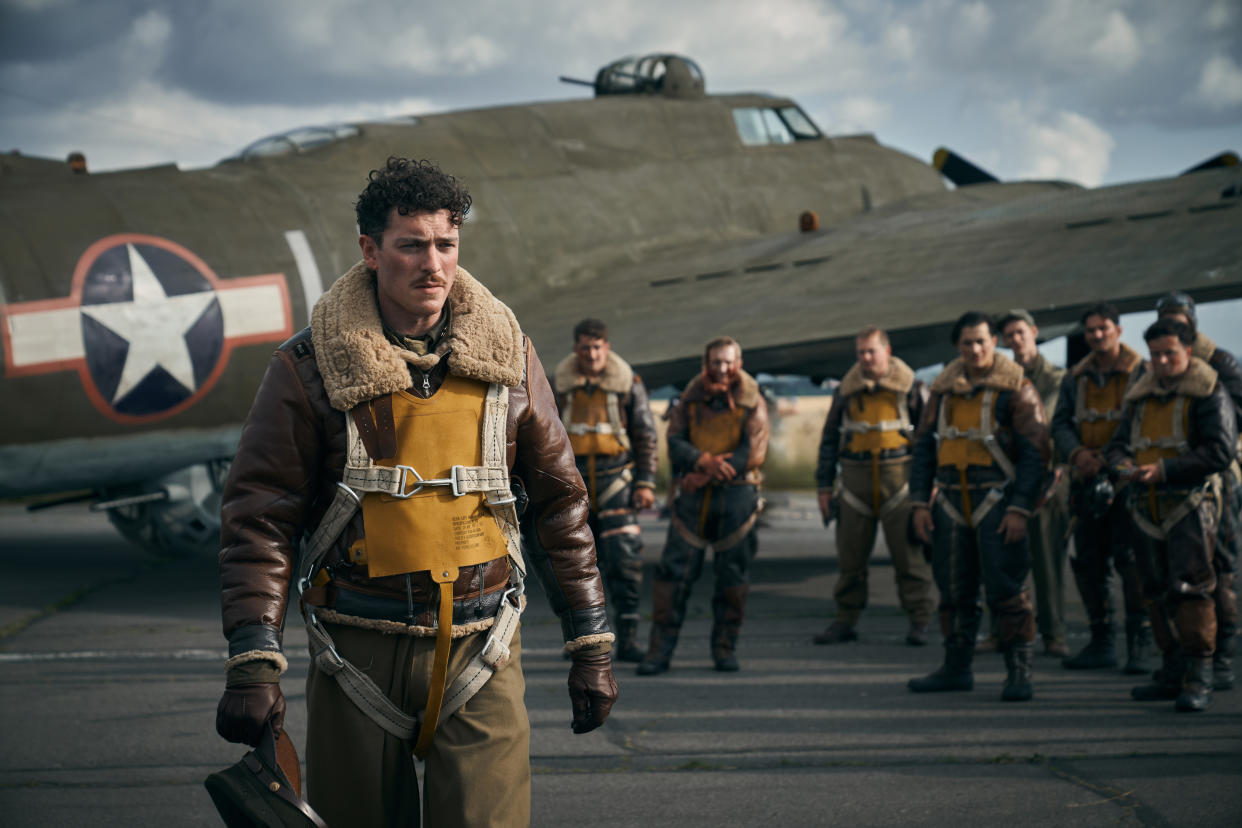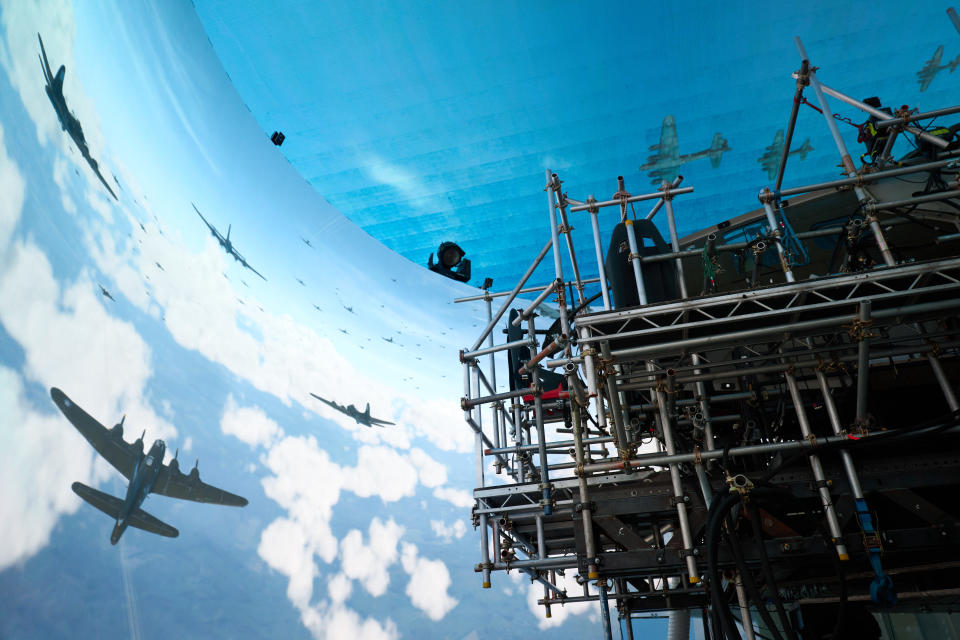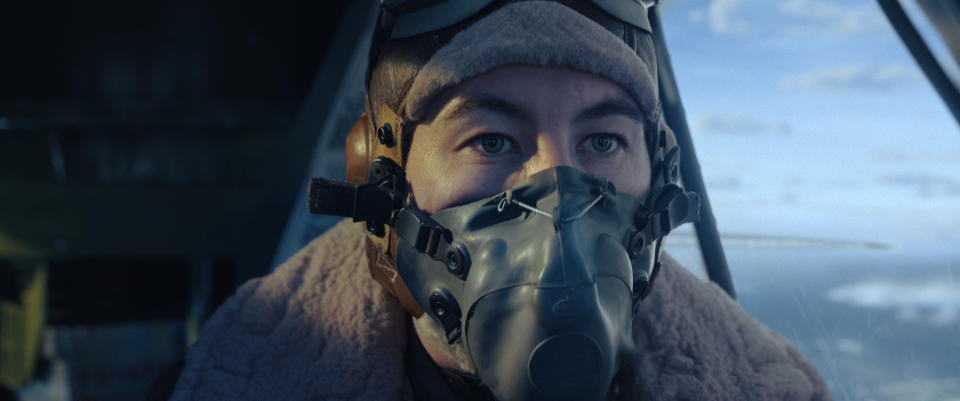‘Masters of the Air’ Had to Recreate ‘Absolutely Terrifying’ Flights for WW2 Battle Sequences

- Oops!Something went wrong.Please try again later.
- Oops!Something went wrong.Please try again later.
When screenwriter John Orloff reunited with “Band of Brothers” producers Gary Goetzman, Tom Hanks, and Steven Spielberg to adapt Donald L. Miller’s “Masters of the Air,” a non-fiction account of the Air Force’s 100th Bomb Group during World War II, he knew he wanted to give the audience a visceral sense of what it was like to there in the planes.
“We all know what infantry combat looks like,” Orloff told IndieWire’s Filmmaker Toolkit podcast. “We’ve seen it over and over and over. We haven’t really seen what these air bomber combat missions were really like. The thing about being in a bomber is you can’t deviate from your course, so it’s a different thing than being a fighter pilot where you get to shoot and dart all around and do whatever you want. When you’re in a bomber, the only way you stay alive is in formation, which means you don’t leave formation, which means whatever comes at you, you just take it. And if you’re inside one of those planes, it is absolutely terrifying.”
More from IndieWire
'Oppenheimer' Wins PGA for Outstanding Producer of Theatrical Motion Pictures (Full List)
Shane Gillis' 'SNL' Firing Looms Over His Hosting Monologue: 'Don't Google That'
Because there are only a few original B-17s still in existence, using the real planes was not an option. “There are only a couple that can still fly, and nobody was going to let us mess with those because they’re too valuable,” Orloff said. “So we built three full-scale replicas for exteriors. One of them could taxi, [none] could fly. And then we built two fuselages for interior stuff, the cockpit and all of that. And we got an amazing visual effects team.” Orloff credits visual effects supervisor Stephen Rosenbaum with creating an environment as specific as it is epic, all while maintaining a rigorous approach to historical authenticity.
“I wanted to show the scale of the air war,” Orloff said, and the greatness of “Masters of the Air” comes in the way that it simultaneously takes the viewer inside the cockpit and shows the massive scope of what is happening outside. Orloff says that Rosenbaum had the added challenge of creating a show that would satisfy the WWII enthusiasts who would be examining every detail. “Stephen did the first ‘Avatar,’ and on that, no one is going to say, ‘Hey, you know the wing on that dragon doesn’t look right,’ because it’s all fantasy. Here, everything’s got to play and feel three-dimensional in a way that we recognize as real.”
Rosenbaum began his research with Miller’s book and tried to think of ways that he could stay historically and technically accurate while also providing the dynamic production value the story required. The first step was storyboards, but from there, Rosenbaum quickly moved on to pre-viz. “We did pre-viz for all the mission sequences, which we would then distribute to the various departments,” Rosenbaum said. “Then we’d sit down and have production meetings to work through who was doing what, basically distributing the workload, breaking it down between stunts, make-up, special effects, and so forth. Storyboards can only tell you so much. The action happens so quickly that to actually understand the choreography, it was very helpful to have that pre-viz.”
The pre-viz became an essential part of production as well, when the filmmakers utilized the Volume for the flying sequences. Essentially an enormous horseshoe-shaped wall of LED television screens, which is also enclosed with a lid of LED screens, the Volume creates an immersive, three-dimensional world that the actors can be surrounded and even lit by. For “Masters of the Air,” the pre-viz was projected onto the Volume so that the actors could react to action that would be recreated in a higher resolution version during post. “The big plus was eyelines,” Rosenbaum said. “The actors could spot an Fw 190 coming at them and whizzing past, and the timing is all correct because we’re moving all the planes at the right speed and in the correct position.”

The Volume also had advantages for the cinematographers. “If there was a big explosion outside the window, the director of photography could time a lighting hit on the wall, and you’d see that illumination on the actors’ faces,” Rosenbaum said. For the exterior shots, Rosenbaum went for a grounded approach to help sell the reality of the epic battles. “Too often, visual effects use these magic cameras that are more observational,” Rosenbaum said. “They’re more witnessing the experience than being part of that experience. I think grounding the cameras is a very effective technique in terms of being present with the characters. Whether we’re inside the plane, or attached to the plane, or in an adjacent plane watching the action, we’re always placing the camera in a physically plausible position.”
Realism was a guiding principle for the sound team as well. “I think authenticity was the first word out of the producers’ mouths,” re-recording mixer Michael Winkler told IndieWire. “Authenticity and heroism.” Like Rosenbaum, the sound team began by scouring Miller’s book for useful details, then went beyond it for further research. “We talked with the military advisors and asked hundreds of questions,” supervising sound editor Jack Whittaker said. “Questions about the types of planes, types of switches, how they were talking to each other on the radios and intercoms — even down to the language that they spoke, because we would use that for the loop group.”

From there, the team went out and recorded B-17s and other authentic materials, which had to be layered with design elements to create the necessary balance between power and fragility that characterized the planes. “We thought of them as fragile beasts,” Whittaker said. “They were quite delicate in a way when they were being shot at, but the engines were like these amazing, roaring muscle cars. We really started with the engines when it came to conveying the drama.” The key was emulating what the pilots would have heard while in the heat of battle. “You’re almost always with the crew, so we were always trying to make the tracks from their perspective.”
At times, pulling sounds out was the solution. “We were relying on contrast by stripping things away and showing how vulnerable these guys were,” re-recording mixer Duncan McRae said. “They weren’t protected by a lot, so to really feel what they were feeling, we would pare down to bare elements when they’re attacked.” Minkler added that fear was the primary emotion that had to be conveyed throughout the series in different ways. “What is someone feeling knowing he could die any second? What is it we want to play? Sometimes it’s the creaking, the breathing, the footsteps. Sometimes it’s the dialogue. We’re constantly going back and forth, doing scenes with heavy music, or no music.” According to Minkler, the process of deciding when music, sound effects, or dialogue would best express an emotion was constantly evolving and the result of collaboration with everyone from Orloff and the producers to the composer and Apple. “Thank God everyone was open to change.”
The fact that the series is nearly 10 hours long made it an even bigger challenge for the sound team, as they had to keep the show from becoming sonically monotonous. “Every one of the battle sequences is different in terms of context and story and visual effects, and so we have to try to make it sound different as well,” Minkler said. For everyone involved, the epic nature of the show was as grueling as it was rewarding. “I think pretty much everybody on this show would say, ‘Yeah, that was the hardest job I ever had,'” Orloff said. “And hopefully one of the most rewarding.”
Best of IndieWire
Christopher Nolan Movies, Ranked from 'The Dark Knight' and 'Tenet' to 'Dunkirk' and 'Oppenheimer'
Where to Watch This Week's New Movies, Including 'Argylle' and 'How to Have Sex'
Christopher Nolan's Favorite Movies: 40 Films the Director Wants You to See
Sign up for Indiewire's Newsletter. For the latest news, follow us on Facebook, Twitter, and Instagram.

